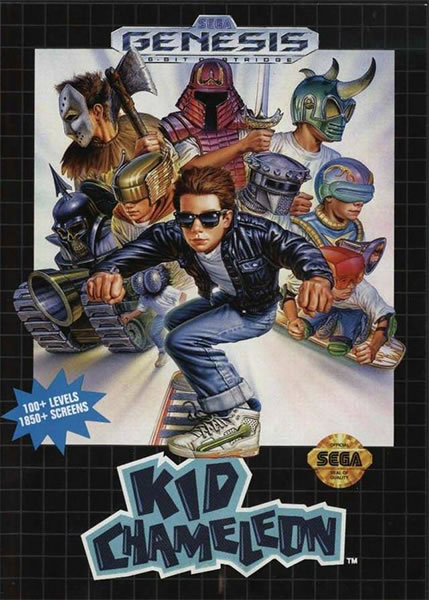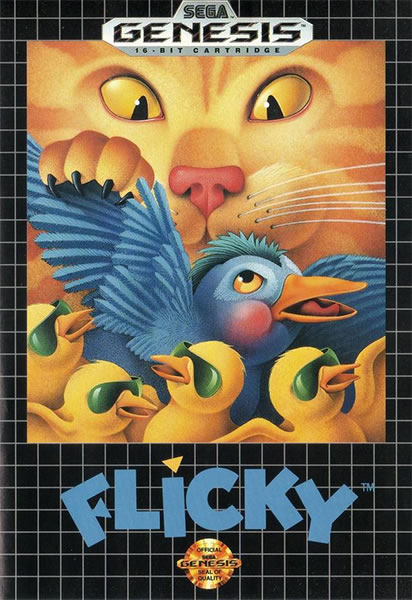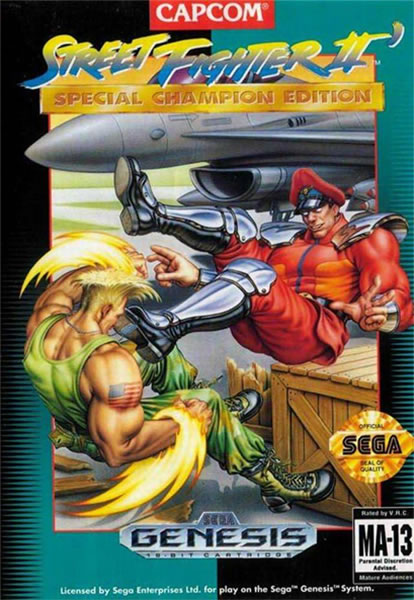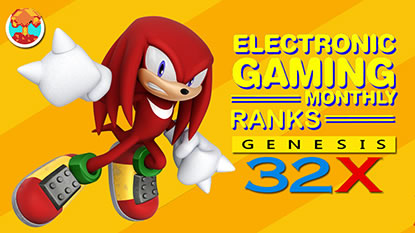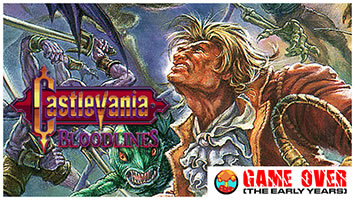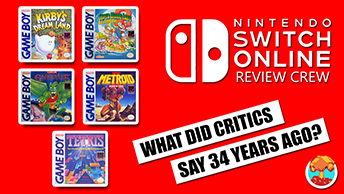- CLASSIC MAGAZINES
- REVIEW CREW
A show recapping what critics thought back
when classic games first came out! - NEXT GENERATION'S BEST & WORST
From the worst 1-star reviews to the best
5-stars can offer, this is Next Generation! - NINTENDO POWER (ARCHIVE)
Experience a variety of shows looking at the
often baffling history of Nintendo Power! - MAGAZINE RETROSPECTIVE
We're looking at the absolutely true history of
some of the most iconic game magazines ever! - SUPER PLAY'S TOP 600
The longest and most ambitious Super NES
countdown on the internet! - THEY SAID WHAT?
Debunking predictions and gossip found
in classic video game magazines! - NEXT GENERATION UNCOVERED
Cyril is back in this spin-off series, featuring the
cover critic review the art of Next Generation! - HARDCORE GAMER MAGAZING (PDF ISSUES)
Download all 36 issues of Hardcore Gamer
Magazine and relive the fun in PDF form!
- REVIEW CREW
- ELECTRONIC GAMING MONTHLY
- ELECTRONIC GAMING MONTHLY RANKS
From Mario to Sonic to Street Fighter, EGM
ranks classic game franchises and consoles! - ELECTRONIC GAMING MONTHLY BEST & WORST
Counting down EGM’s best and worst reviews
going year by year, from 1989 – 2009! - ELECTRONIC GAMING BEST & WORST AWARDS
11-part video series chronicling the ups and
downs of EGM’s Best & Worst Awards!
- ELECTRONIC GAMING MONTHLY RANKS
- GAME HISTORY
- GAME OVER: STORY BREAKDOWNS
Long-running series breaking down game
stories and analyzing their endings! - A BRIEF HISTORY OF GAMING w/ [NAME HERE]
Real history presented in a fun and pithy
format from a variety of game historians! - THE BLACK SHEEP
A series looking back at the black sheep
entries in popular game franchises! - INSTANT EXPERT
Everything you could possibly want to know
about a wide variety of gaming topics! - FREEZE FRAME
When something familiar happens in the games
industry, we're there to take a picture! - I'VE GOT YOUR NUMBER
Learn real video game history through a series
of number-themed episodes, starting at zero! - GREAT MOMENTS IN BAD ACTING
A joyous celebration of some of gaming's
absolute worst voice acting!
- GAME OVER: STORY BREAKDOWNS
- POPULAR SHOWS
- DG NEWS w/ LORNE RISELEY
Newsman Lorne Riseley hosts a regular
series looking at the hottest gaming news! - REVIEW REWIND
Cyril replays a game he reviewed 10+ years
ago to see if he got it right or wrong! - ON-RUNNING FEUDS
Defunct Games' longest-running show, with
editorials, observations and other fun oddities! - DEFUNCT GAMES QUIZ (ARCHIVE)
From online quizzes to game shows, we're
putting your video game knowledge to the test!- QUIZ: ONLINE PASS
Take a weekly quiz to see how well you know
the news and current gaming events! - QUIZ: KNOW THE GAME
One-on-one quiz show where contestants
find out if they actually know classic games! - QUIZ: THE LEADERBOARD
Can you guess the game based on the classic
review? Find out with The Leaderboard!
- QUIZ: ONLINE PASS
- DEFUNCT GAMES VS.
Cyril and the Defunct Games staff isn't afraid
to choose their favorite games and more! - CYRIL READS WORLDS OF POWER
Defunct Games recreates classic game
novelizations through the audio book format!
- DG NEWS w/ LORNE RISELEY
- COMEDY
- GAME EXPECTANCY
How long will your favorite hero live? We crunch
the numbers in this series about dying! - VIDEO GAME ADVICE
Famous game characters answer real personal
advice questions with a humorous slant! - FAKE GAMES: GUERILLA SCRAPBOOK
A long-running series about fake games and
the people who love them (covers included)! - WORST GAME EVER
A contest that attempts to create the worst
video game ever made, complete with covers! - LEVEL 1 STORIES
Literature based on the first stages of some
of your favorite classic video games! - THE COVER CRITIC
One of Defunct Games' earliest shows, Cover
Critic digs up some of the worst box art ever! - COMMERCIAL BREAK
Take a trip through some of the best and
worst video game advertisements of all time! - COMIC BOOK MODS
You've never seen comics like this before.
A curious mix of rewritten video game comics!
- GAME EXPECTANCY
- SERIES ARCHIVE
- NINTENDO SWITCH ONLINE ARCHIVE
A regularly-updated list of every Nintendo
Switch Online release, plus links to review! - PLAYSTATION PLUS CLASSIC ARCHIVE
A comprehensive list of every PlayStation
Plus classic release, including links! - RETRO-BIT PUBLISHING ARCHIVE
A regularly-updated list of every Retro-Bit
game released! - REVIEW MARATHONS w/ ADAM WALLACE
Join critic Adam Wallace as he takes us on a
classic review marathon with different themes!- DEFUNCT GAMES GOLF CLUB
Adam Wallace takes to the links to slice his way
through 72 classic golf game reviews! - 007 IN PIXELS
Adam Wallace takes on the world's greatest spy
as he reviews 15 weeks of James Bond games! - A SALUTE TO VAMPIRES
Adam Wallace is sinking his teeth into a series
covering Castlevania, BloodRayne and more! - CAPCOM'S CURSE
Adam Wallace is celebrating 13 days of Halloween
with a line-up of Capcom's scariest games! - THE FALL OF SUPERMAN
Adam Wallace is a man of steel for playing
some of the absolute worst Superman games! - THE 31 GAMES OF HALLOWEEN
Adam Wallace spends every day of October afraid
as he reviews some of the scariest games ever! - 12 WEEKS OF STAR TREK
Adam Wallace boldly goes where no critic has
gone before in this Star Trek marathon!
- DEFUNCT GAMES GOLF CLUB
- DAYS OF CHRISTMAS (ARCHIVE)
Annual holiday series with themed-episodes
that date all the way back to 2001!- 2015: 30 Ridiculous Retro Rumors
- 2014: 29 Magazines of Christmas
- 2013: 29 Questionable Power-Ups of Christmas
- 2012: 34 Theme Songs of Christmas
- 2011: 32 Game Endings of Christmas
- 2010: 31 Bonus Levels of Christmas
- 2009: 30 Genres of Christmas
- 2008: 29 Controls of Christmas
- 2007: 34 Cliches of Christmas
- 2006: 33 Consoles of Christmas
- 2005: 32 Articles of Christmas
- 2004: 31 Websites of Christmas
- 2003: 29 Issues of Christmas
- 2002: 28 Years of Christmas
- 2001: 33 Days of Christmas
- NINTENDO SWITCH ONLINE ARCHIVE
- REVIEW ARCHIVE
- FULL ARCHIVE
Nintendo Switch Online: 1990s Critics Review Street Fighter II Special & Kid Chameleon
Admit it retro heads, this has been a surprisingly great year for the Nintendo Switch Online service. Ever since they uploaded the Game Boy line of consoles, Nintendo has been good about updating the classic game space every two or three weeks. This newest update brings four Genesis games to the Expansion Pack, including Kid Chameleon, Flicky, Street Fighter II: Special Champion Edition and Pulseman. That's exciting news, but the question remains: Are these games actually worth playing? To answer that question, I decided to flip through the pages of Electronic Gaming Monthly, Video Games & Computer Entertainment, Die Hard Game Fan and more classic magazines to see what the critics said about these games when they first came out. Well, all of them except for Pulseman, which didn't find its way outside of Japan until 2009. So, grab your favorite mask and practice those hadoukens, because this is another action-packed episode of Nintendo Switch Online Review Crew.
While Sega was confident that Sonic the Hedgehog would be their next big breakout star, they did hedge their bets with a back-up plan, and his name was Kid Chameleon. This was a side-scroller in the spirit of Super Mario Bros. that starred a teenage boy who was able to take on a series of powers by wearing different masks. It was basically Sega's version of the different costumes found in Mario 3, though there is more of a focus on combat in Kid Chameleon. The other big gimmick was that it contained more than 1,800 levels (or screens) to explore, a talking point that is a lot more impressive on paper than in execution. But hey, that's just me. Let's see what the critics said back in 1992.
While Electronic Gaming Monthly certainly enjoyed Kid Chameleon, it was definitely not seen as one of Sega's best games of that era. Half of the EGM staff gave the game eights, while the other half gave it sevens, leading to a predictable average score of 7.5 out of 10. Steve gushed that “the depth and overall theme of this game is really wonderful. Not only is the action in this game presented well, but beyond the hero-enemy interaction are a variety of other play mechanics that require you to discover just who's the best person to be in each situation.” Sushi-X was even more impressed, calling the game “awesome” and arguing that “Kid Chameleon is the most radical video game hero to come around since Sonic. If you want a REAL challenge, take on the video game adventure of a lifetime.” He argued that it was a must for anybody who loves Mario or Sonic.
Video Games & Computer Entertainment was equally conflicted, liking the gameplay but being disappointed by the lack of originality. They called it a Mario clone and then described the concept as stitching together virtual reality and the holodeck from Star Trek: The Next Generation. They concluded that “Kid Chameleon has nonstop varied action to make you come back for more. Helped by ease of play, its familiarity is reassuring rather than off-putting. This is a very well-executed exercise in the mediocre. Considering what's offered nowadays, that speaks volumes.”
You ended up seeing similar scores from Computer & Video Games, who gave it an 80% in issue 125. Mean Machines was right in line with a 78%. And Sega Pro went as high as an 89%. However, if you're looking for Kid Chameleon's highest score, then look no further than GamePro. Giving it a perfect 5 out of 5, critic Earth Angel notes that “It takes a while to realize that Kid Chameleon's not just another pretty face. It has a clever combination of Alex Kidd's best games, puzzle strategy elements, and arcade-style action. The game introduces enough different faces to please almost all gamers. One of the hottest Genesis action games to hit the Winter Consumer Electronics Show, this Kid is sure to give you your money's worth. Hey, would we kid you?” I mean, you gave the game a perfect score, so ... maybe?? Look, I think that Kid Chameleon is a great game with a lot of interesting ideas to offer, but it's far from perfect. Thankfully, you can see for yourself when you play this 1992 Sega classic on the Nintendo Switch.
Originally released all the way back in 1984 as a plucky arcade game, Flicky is a Mappy-esque platformer where you take control of a blue bird who is tasked with gathering up a bunch of small birds before they are eaten by the neighborhood cats. Sure, it's not the flashiest Genesis game we're going to talk about today, but don't sleep on Flicky. This is an enjoyable action game with a simple premise that makes it feel timeless. And it's not just me saying this, because the critics agreed – Flicky is awesome!
Let's start by looking at Rich's review for Mean Machines, which uses some language that you definitely won't see in 2023: “Curiosity aroused, I decided to give Flicky a go, and to my incredible surprise, I found myself addicted, despite the truly awful graphics (designed no doubt by some retarded nursery school graduate) and very annoying sound (cutesy tunes have never sounded so utterly nauseating).” He loved the amount of replay the game had, despite the terrible presentation. Mean Machines gave Flicky an average score of 92%.
While Mean Machines went high, the rest of the British critics followed suit. For example, you saw Mega Tech give the game an 83% in their very first issue. That's not far off from Computer & Video Games, who gave it an 84% and said that “for a game consisting of a single-screen, wrap-around stage, Flicky is surprisingly brill. No need for massive scrolling levels or huge, axe-wielding sprites here – all the characters are tiny, but they animate very well, especially Flicky himself. The Mega Drive is somewhat starved for cute platform titles and Flicky is a welcome new laff on the machine.”
Of course, not every magazine was thrilled about the game's outdated graphics and arcade gameplay. Electronic Gaming Monthly, for example, had very little good to say about Flicky. Steve called it a “low cost game for the Genesis aimed purely at the younger player. The theme is cute, as are the characters, but 99 levels is a little much.” Ed was the sole Review Crew member to not give the game a five, though his six wasn't much better: “Not for everybody, but once you try it you probably will want to keep on playing. Not bad, but not great.” Flicky averaged a very middle of the road 5.25 out of 10 from Electronic Gaming Monthly. Perhaps I'm just young at heart, but I liked it a lot more than that. Find out who is right when you get to know Flicky on the Switch.
It's hard to believe now, but there was a time when Street Fighter II was exclusive to Nintendo. Back when it first hit Super NES in 1992, Ryu, Ken and all of the World Warriors were used to pushback against Sonic, Streets of Rage and the rest of Sega's 16-bit line-up. But like so many console exclusives go, Capcom eventually realized that they could make a lot more money by porting their biggest game to all consoles. That's where Street Fighter II: Special Champion Edition comes in. Announced only a few months after the vanilla version hit Super NES, this was an upgrade that allowed you to not only play as the four boss characters, but also experience more moves and extras that were a step beyond the arcade Champion Edition. Unfortunately, the game ended up getting delayed and Capcom announced the even more advanced Street Fighter II Turbo on Super NES, but for a few months in 1993, Genesis fans couldn't be more excited. Was this hype justified?
Yes ... for the most part. Look, this is one of those situations where a delay probably kept a game from getting higher scores. It's not that the critics didn't like Special Champion Edition, but rather that Street Fighter II Turbo completely overshadowed it. That's why you see a lot of reviews directly comparing the versions, which unfortunately means that you're going to hear a lot about Special's flaws. For example, Electronic Gaming Monthly's Steve argued that “this version looks and plays just like the Super NES version, minus a few colors. Though the graphics are there, the sound track and voice are horrible! It really is that bad!” Ed agreed, but went a step further with a warning: “Don't even think about using the 3-button controller – it blows. Use a 6-button and you'll be much happier. Now, for The Flaw. The sound is horrible and it sounds like each character has laryngitis.” Street Fighter II: Special Champion Edition earned an average of 8.25 out of 10.
That's in line with Force Mega, who gave the game 83% in their sixth issue and complained about the presentation. However, those two magazines were on the low side, as most publications weren't willing to go lower than 90%. For example, it got a 92% from Mega in their sixteenth issue and an impressive 96% from Sega Magazine in their debut installment. Die Hard Game Fan went even higher, with an average score of 97%. Sgt. Gamer gushed that if you “take everything that Capcom did with both Super NES Street Fighter II games, that's what you get in Special – the speed, the moves, the graphics, boss vs. boss and more. The only meaningful difference is the music, which is not up to the Super NES standards.” Skid also loved the game, but for a completely different (and much weirder) reason: “Finally! A Sega version. Now I can play a lightning fast 24 meg Street Fighter II with a controller that doesn't look like a Milk Bone.”
Believe it or not, there was one magazine that went even higher than Die Hard Game Fan, and that magazine was GamePro. Yeah, it's always GamePro. Giving it a perfect 5 out of 5, they called Street Fighter II Special “a close conversion of the arcade Hyper Fighting. The voices are barely comprehensible, but overall this cart's a Champion among Sega fighting games.” That said, they did go on to conclude that “without a question, doubt or hesitation, the Super NES version beats out the Genesis edition by virtue of better graphics and sound.” Although it may have frustrated Sega fans back in the mid-90s, this is a fair and accurate read of the situation. The version you play with a Milk Bone controller is definitely better, but Street Fighter II: Special Champion Edition is still a lot of fun.
| Publication | Scores |
|---|---|
| GamePro | 5/5 |
| Game Informer | 9/10 |
| Sega Pro | 89% |
| Computer & Video Games | 80% |
| Mean Machines | 78% |
| Electronic Gaming Monthly | 7.5/10 |
| Video Games & Computer Entertainment | 7/10 |
| AVERAGE SCORE | 83% |
While Electronic Gaming Monthly certainly enjoyed Kid Chameleon, it was definitely not seen as one of Sega's best games of that era. Half of the EGM staff gave the game eights, while the other half gave it sevens, leading to a predictable average score of 7.5 out of 10. Steve gushed that “the depth and overall theme of this game is really wonderful. Not only is the action in this game presented well, but beyond the hero-enemy interaction are a variety of other play mechanics that require you to discover just who's the best person to be in each situation.” Sushi-X was even more impressed, calling the game “awesome” and arguing that “Kid Chameleon is the most radical video game hero to come around since Sonic. If you want a REAL challenge, take on the video game adventure of a lifetime.” He argued that it was a must for anybody who loves Mario or Sonic.
Video Games & Computer Entertainment was equally conflicted, liking the gameplay but being disappointed by the lack of originality. They called it a Mario clone and then described the concept as stitching together virtual reality and the holodeck from Star Trek: The Next Generation. They concluded that “Kid Chameleon has nonstop varied action to make you come back for more. Helped by ease of play, its familiarity is reassuring rather than off-putting. This is a very well-executed exercise in the mediocre. Considering what's offered nowadays, that speaks volumes.”
You ended up seeing similar scores from Computer & Video Games, who gave it an 80% in issue 125. Mean Machines was right in line with a 78%. And Sega Pro went as high as an 89%. However, if you're looking for Kid Chameleon's highest score, then look no further than GamePro. Giving it a perfect 5 out of 5, critic Earth Angel notes that “It takes a while to realize that Kid Chameleon's not just another pretty face. It has a clever combination of Alex Kidd's best games, puzzle strategy elements, and arcade-style action. The game introduces enough different faces to please almost all gamers. One of the hottest Genesis action games to hit the Winter Consumer Electronics Show, this Kid is sure to give you your money's worth. Hey, would we kid you?” I mean, you gave the game a perfect score, so ... maybe?? Look, I think that Kid Chameleon is a great game with a lot of interesting ideas to offer, but it's far from perfect. Thankfully, you can see for yourself when you play this 1992 Sega classic on the Nintendo Switch.
| Publication | Scores |
|---|---|
| Mean Machines | 92% |
| Computer & Video Games | 84% |
| MegaTech | 83% |
| Electronic Gaming Monthly | 5.25/10 |
| Mega Play | 5/10 |
| AVERAGE SCORE | 72% |
Let's start by looking at Rich's review for Mean Machines, which uses some language that you definitely won't see in 2023: “Curiosity aroused, I decided to give Flicky a go, and to my incredible surprise, I found myself addicted, despite the truly awful graphics (designed no doubt by some retarded nursery school graduate) and very annoying sound (cutesy tunes have never sounded so utterly nauseating).” He loved the amount of replay the game had, despite the terrible presentation. Mean Machines gave Flicky an average score of 92%.
While Mean Machines went high, the rest of the British critics followed suit. For example, you saw Mega Tech give the game an 83% in their very first issue. That's not far off from Computer & Video Games, who gave it an 84% and said that “for a game consisting of a single-screen, wrap-around stage, Flicky is surprisingly brill. No need for massive scrolling levels or huge, axe-wielding sprites here – all the characters are tiny, but they animate very well, especially Flicky himself. The Mega Drive is somewhat starved for cute platform titles and Flicky is a welcome new laff on the machine.”
Of course, not every magazine was thrilled about the game's outdated graphics and arcade gameplay. Electronic Gaming Monthly, for example, had very little good to say about Flicky. Steve called it a “low cost game for the Genesis aimed purely at the younger player. The theme is cute, as are the characters, but 99 levels is a little much.” Ed was the sole Review Crew member to not give the game a five, though his six wasn't much better: “Not for everybody, but once you try it you probably will want to keep on playing. Not bad, but not great.” Flicky averaged a very middle of the road 5.25 out of 10 from Electronic Gaming Monthly. Perhaps I'm just young at heart, but I liked it a lot more than that. Find out who is right when you get to know Flicky on the Switch.
| Publication | Scores |
|---|---|
| GamePro | 5/5 |
| Die Hard Game Fan | 97% |
| Sega Magazine | 96% |
| Mega | 92% |
| Video Games & Computer Entertainment | 9/10 |
| Sega Force Mega | 83% |
| Electronic Gaming Monthly | 8.25/10 |
| AVERAGE SCORE | 92% |
Yes ... for the most part. Look, this is one of those situations where a delay probably kept a game from getting higher scores. It's not that the critics didn't like Special Champion Edition, but rather that Street Fighter II Turbo completely overshadowed it. That's why you see a lot of reviews directly comparing the versions, which unfortunately means that you're going to hear a lot about Special's flaws. For example, Electronic Gaming Monthly's Steve argued that “this version looks and plays just like the Super NES version, minus a few colors. Though the graphics are there, the sound track and voice are horrible! It really is that bad!” Ed agreed, but went a step further with a warning: “Don't even think about using the 3-button controller – it blows. Use a 6-button and you'll be much happier. Now, for The Flaw. The sound is horrible and it sounds like each character has laryngitis.” Street Fighter II: Special Champion Edition earned an average of 8.25 out of 10.
That's in line with Force Mega, who gave the game 83% in their sixth issue and complained about the presentation. However, those two magazines were on the low side, as most publications weren't willing to go lower than 90%. For example, it got a 92% from Mega in their sixteenth issue and an impressive 96% from Sega Magazine in their debut installment. Die Hard Game Fan went even higher, with an average score of 97%. Sgt. Gamer gushed that if you “take everything that Capcom did with both Super NES Street Fighter II games, that's what you get in Special – the speed, the moves, the graphics, boss vs. boss and more. The only meaningful difference is the music, which is not up to the Super NES standards.” Skid also loved the game, but for a completely different (and much weirder) reason: “Finally! A Sega version. Now I can play a lightning fast 24 meg Street Fighter II with a controller that doesn't look like a Milk Bone.”
Believe it or not, there was one magazine that went even higher than Die Hard Game Fan, and that magazine was GamePro. Yeah, it's always GamePro. Giving it a perfect 5 out of 5, they called Street Fighter II Special “a close conversion of the arcade Hyper Fighting. The voices are barely comprehensible, but overall this cart's a Champion among Sega fighting games.” That said, they did go on to conclude that “without a question, doubt or hesitation, the Super NES version beats out the Genesis edition by virtue of better graphics and sound.” Although it may have frustrated Sega fans back in the mid-90s, this is a fair and accurate read of the situation. The version you play with a Milk Bone controller is definitely better, but Street Fighter II: Special Champion Edition is still a lot of fun.
HOME |
CONTACT |
NOW HIRING |
WHAT IS DEFUNCT GAMES? |
NINTENDO SWITCH ONLINE |
RETRO-BIT PUBLISHING
Retro-Bit |
Switch Planet |
The Halcyon Show |
Same Name, Different Game |
Dragnix |
Press the Buttons
Game Zone Online | Hardcore Gamer | The Dreamcast Junkyard | Video Game Blogger
Dr Strife | Games For Lunch | Mondo Cool Cast | Boxed Pixels | Sega CD Universe | Gaming Trend
Game Zone Online | Hardcore Gamer | The Dreamcast Junkyard | Video Game Blogger
Dr Strife | Games For Lunch | Mondo Cool Cast | Boxed Pixels | Sega CD Universe | Gaming Trend
Copyright © 2001-2025 Defunct Games
All rights reserved. All trademarks are properties of their respective owners.
All rights reserved. All trademarks are properties of their respective owners.







